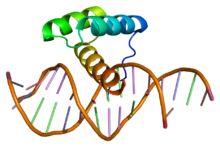- MSX1
-
Msh homeobox 1 
Estructura tridimensional de la proteína MSX1.HUGO 7391 Símbolo MSX1 Símbolos alt. HOX7; HYD1 Datos genéticos Locus Cr. 4 p16.2 Bases de datos Entrez 4487 OMIM 142983 PDB 1ig7 RefSeq NP_002439 UniProt P28360 Msh homeobox 1, también conocida como MSX1, es una proteína codificada en humanos por el gen msx1.[1] [2]
Contenido
Función
Esta proteína pertenece a la familia de genes homeóticos de segmentación muscular, y actúa como un represor transcripcional durante el proceso de embriogénesis por medio de interacciones con componentes del complejo de transcripción y con otras homeoproteínas. También podría tener un papel en la formación del patrón límbico, en el desarrollo craneofacial, especialmente en la odontogénesis, y en la inhibición del crecimiento de tumores. Se han asociado mutaciones en este gen, inicialmente conocido como homeobox 7, con labio leporino no sindrómico con o sin paladar hendido,[3] [4] [5] síndrome de Witkop, síndrome de Wolf-Hirschhorn e hipodontia autosómica dominante.[6]
Interacciones
La proteína MSX1 ha demostrado ser capaz de interaccionar con:
- DLX5[7]
- CREBBP[8]
- Factor de transcripción Sp1[8]
- DLX2[7]
- Proteína de unión a TATA[8] [7] [9]
- MSX2[7]
Referencias
- ↑ Hewitt JE, Clark LN, Ivens A, Williamson R (November 1991). «Structure and sequence of the human homeobox gene HOX7». Genomics 11 (3): pp. 670–8. doi:. PMID 1685479.
- ↑ McAlpine PJ, Shows TB (July 1990). «[h Nomenclature for human homeobox genes]». Genomics 7 (3): pp. 460. doi:. PMID 1973146. h.
- ↑ van den Boogaard MJ, Dorland M, Beemer FA, van Amstel HK (April 2000). «MSX1 mutation is associated with orofacial clefting and tooth agenesis in humans». Nat. Genet. 24 (4): pp. 342–3. doi:. PMID 10742093.
- ↑ Jezewski PA, Vieira AR, Nishimura C, Ludwig B, Johnson M, O'Brien SE, Daack-Hirsch S, Schultz RE, Weber A, Nepomucena B, Romitti PA, Christensen K, Orioli IM, Castilla EE, Machida J, Natsume N, Murray JC (June 2003). «Complete sequencing shows a role for MSX1 in non-syndromic cleft lip and palate». J. Med. Genet. 40 (6): pp. 399–407. doi:. PMID 12807959.
- ↑ Suzuki Y, Jezewski PA, Machida J, Watanabe Y, Shi M, Cooper ME, Viet le T, Nguyen TD, Hai H, Natsume N, Shimozato K, Marazita ML, Murray JC (2004). «In a Vietnamese population, MSX1 variants contribute to cleft lip and palate». Genet. Med. 6 (3): pp. 117–25. PMID 15354328. http://meta.wkhealth.com/pt/pt-core/template-journal/lwwgateway/media/landingpage.htm?issn=1098-3600&volumen=6&número=3&spage=117.
- ↑ «Entrez Gene: MSX1 msh homeobox 1».
- ↑ a b c d Zhang, H; Hu G, Wang H, Sciavolino P, Iler N, Shen M M, Abate-Shen C (May. 1997). «Heterodimerization of Msx and Dlx homeoproteins results in functional antagonism». Mol. Cell. Biol. (UNITED STATES) 17 (5): pp. 2920–32. ISSN 0270-7306. PMID 9111364.
- ↑ a b c Shetty, S; Takahashi T, Matsui H, Ayengar R, Raghow R (May. 1999). «Transcriptional autorepression of Msx1 gene is mediated by interactions of Msx1 protein with a multi-protein transcriptional complex containing TATA-binding protein, Sp1 and cAMP-response-element-binding protein-binding protein (CBP/p300)». Biochem. J. (ENGLAND) 339 ( Pt 3): pp. 751–8. ISSN 0264-6021. PMID 10215616.
- ↑ Zhang, H; Catron K M, Abate-Shen C (Mar. 1996). «A role for the Msx-1 homeodomain in transcriptional regulation: residues in the N-terminal arm mediate TATA binding protein interaction and transcriptional repression». Proc. Natl. Acad. Sci. U.S.A. (UNITED STATES) 93 (5): pp. 1764–9. ISSN 0027-8424. PMID 8700832.
Enlaces externos
Categorías:- Genes del cromosoma 4
- Factores de transcripción
Wikimedia foundation. 2010.
